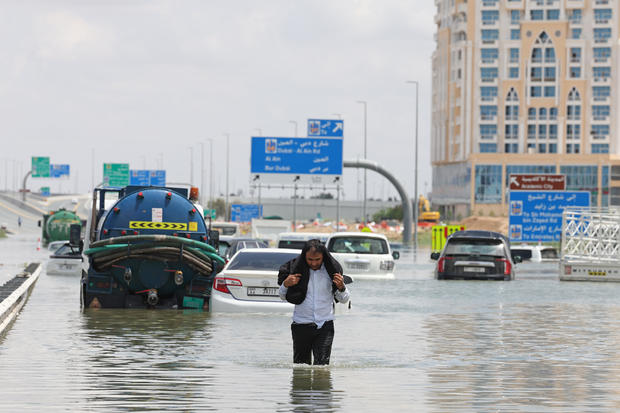What is cloud seeding and did it play any role in the Dubai floods?
Stranded airline passengers and a cat submerged in floodwaters clinging to a car door handle became notable moments this week in Dubai as the normally arid city was inundated with historic levels of rain. Claims have gone viral that the deluge was brought on by cloud seeding, a technique that aims to increase precipitation, that is heavily utilized in the United Arab Emirates.
But is it really to blame?
Daniel Swain, a climate scientist at the University of California, Los Angeles, said that getting to the bottom of the "record-shattering extreme rainfall" requires breaking down the science behind the event and the technique.
"There's currently a disconnect in the online discourse between the kind of human activities that likely did affect it (greenhouse warming) versus those which have actually been the focus of the online conversation thus far (cloud seeding), and what this means for how we collectively understand our ability to actively affect the weather on different spatial and temporal scales," he said in an emailed statement.
What is cloud seeding?
Many have questioned since the downpour in Dubai whether cloud seeding was to blame. But what is cloud seeding and how does it work exactly?
Cloud seeding is a technique used to improve precipitation. According to the Desert Research Institute, scientists do this by putting tiny particles called nuclei into the atmosphere that attach to clouds.
"These nuclei provide a base for snowflakes to form. After cloud seeding takes place, the newly formed snowflakes quickly grow and fall from the clouds back to the surface of the Earth, increasing snowpack and streamflow," the institute says.
In the Middle East, instead of precipitation in the form of snow, its cloud seeding program generates increased rain.
Scientists typically go about cloud seeding in two ways – using either generators on the ground or distributing the nuclei via aircraft.
What caused the rain in Dubai?
But was the rain in Dubai from cloud seeding?
"Did cloud seeding play a role? Likely no," Swain said. "But how about climate change? Likely yes!"
The world is continuing to see month after month of record-breaking heat and 2023 was the hottest year globally ever recorded. Scientists have found that warmer temperatures increase evaporation, resulting in more frequent and intense storms, such as the one that occurred in Dubai. Those conditions also fuel other extreme weather events, including droughts, putting opposing forces at intense odds that will likely strain communities without adequate adaptation.
Andrew Kruczkiewicz, senior researcher at Columbia Climate School, told CBS News he doesn't believe there's any current evidence at this time that cloud seeding pushed the downpour over the edge.
"This event was forecast fairly well days in advance and I think it's unlikely that a cloud seeding operation would move forward given the well-forecast intense rainfall," he said.
The nation's National Emergency Crisis and Management Authority issued weather warnings on Monday before the storm's arrival, urging people to comply with local instructions from authorities and asking them to stay at home and only leave in the case of an emergency.
Meteorologist Ryan Maue, former chief scientist at the U.S. National Oceanic and Atmospheric Administration, gave the Associated Press a more definitive answer: "It's most certainly not cloud seeding."
"If that occurred with cloud seeding, they'd have water all the time," he said. "...when it comes to controlling individual rain storms, we are not anywhere close to that. And if we were capable of doing that, I think we would be capable of solving many more difficult problems than creating a rain shower over Dubai."
The deluge, he said, "speaks more to questions around what are the resilience measures that are integrated into the urban planning standard operating procedures."
"Almost everywhere on Earth there is a risk of flash flooding," he said. "Yet, since it's not the most frequent type of extreme event, sometimes it's lower on the priority list when decisions need to be made around infrastructure or resilience, or just urban development more broadly."
How significant was the flooding in Dubai?
More than 5.59 inches of rain fell over Dubai within 24 hours. While a half-foot of rain may not seem like much numerically, that's more than what the city sees in an average year, and other parts of the UAE saw even higher levels.
It was a "historic weather event," the state-run WAM news agency said, adding that it was beyond "anything documented since the start of data collection in 1949."
Dubai is normally dry and with a downpour like this being so unprecedented, the city's infrastructure was not prepared. The drainage systems were overwhelmed and Dubai International Airport, one of the busiest in the world, had to temporarily halt operations. One plane passenger told Reuters many people were waiting more than 12 hours to be able to resume travel. Footage from the airport shows planes taxiing in eerie floodwaters.
"Over a year's worth of rainfall was experienced in just a few hours," Kruczkiewicz told CBS News. "And why that's important to to understand is that when you see this amount of rainfall in semi-arid arid area, the soil isn't designed to filter the water as fast as in other areas. ... You don't need that much water falling or rainfall falling in a short period of time to cause major issues."
Is cloud seeding effective?
According to the Desert Research Institute, how effective cloud seeding is depends on the specific project in which it's being used. Citing several studies, the institute said it's helped increase overall snowpack in some areas by at least 10% per year. Another study found that a five-year project in New South Wales, Australia resulted in a 14% snowfall increase.
The UAE's National Center of Meteorology launched the Research Program for Rain Enhancement Science to advance the technology, saying that for dryer regions across the world, cloud seeding "could offer a viable, cost-effective supplement to existing water supplies." Many regions even beyond the Middle East have been suffering from water scarcity issues, including Colombia, Mexico and Hawaii.






